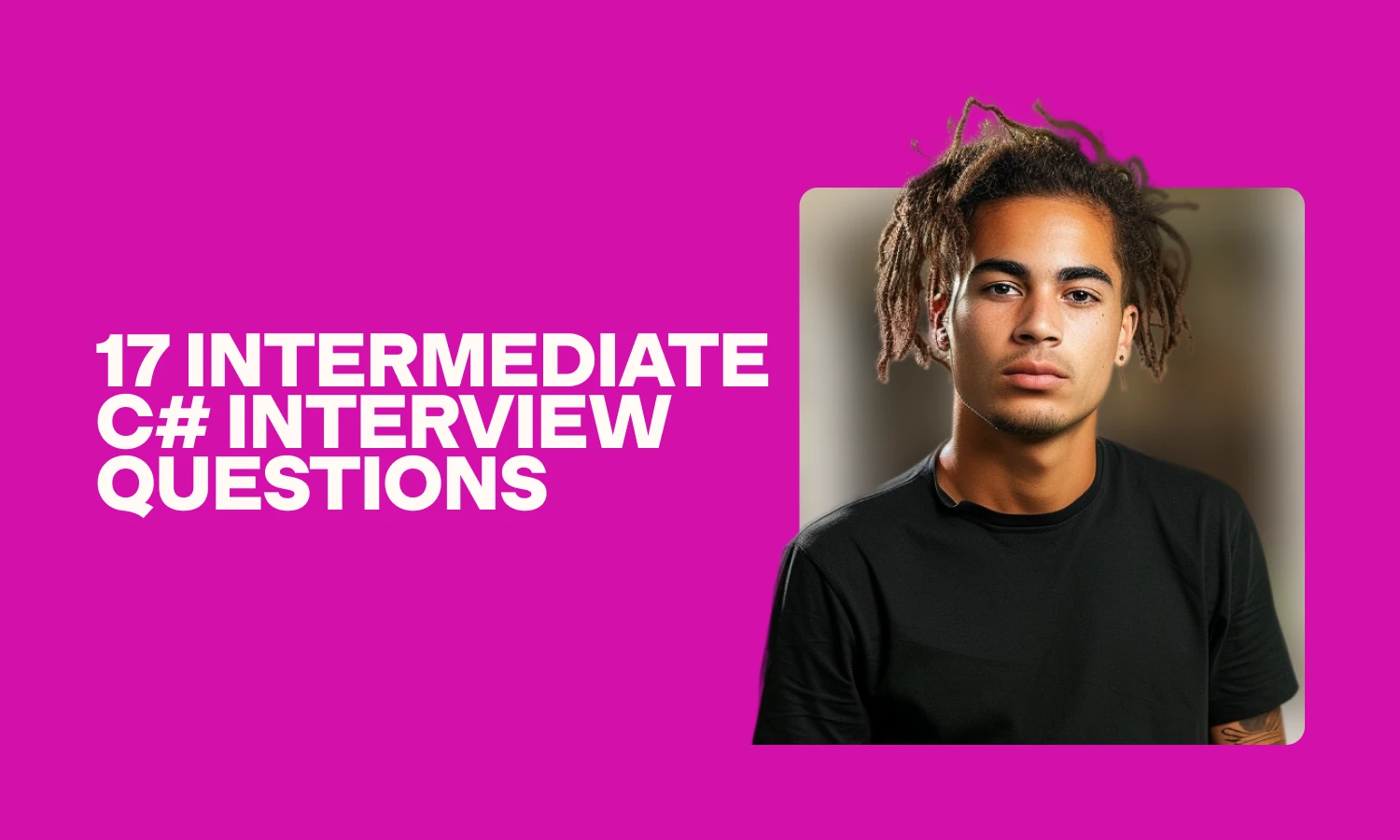50 C# interview questions to find the best developer
Hire top C# developers with TestGorilla
Since its release in 2000, C# has built a reputation as one of the most reliable, diverse, and widely used programming languages around. It can be used for creating mobile and desktop apps as well as web pages, making C# highly coveted for many companies.
If you’re recruiting a new C# developer, a well-planned candidate selection process can boost your chances of finding the right fit. Interviews are a great way to learn more about each candidate’s coding background once they have passed an initial programming skills test, such as a C# test for entry-level algorithms, a C# test for data structures, or a C# test for debugging.
To improve the quality of hire, make sure to tailor the recruitment process to reflect your business’ programming needs and also to use assessments for the appropriate experience level.
Table of contents
- C# interview questions and sample answers for recruiters and hiring managers
- 17 beginner C# interview questions
- 17 intermediate C# interview questions
- 16 advanced C# interview questions
- At which stage of the hiring process should you use C# interview questions?
- Making the best hire is easy with the right C# skills tests and interview questions
C# interview questions and sample answers for recruiters and hiring managers
With our 50 questions and sample answers below, spread across beginner, intermediate, and advanced levels, you can achieve both of these things.
17 beginner C# interview questions
Beginner interview questions target junior or entry-level C# developers. Use these for candidates at the start of their careers.
1. What is the role of C#?
Sample answer:
The role of C# as a programming language is to precisely define a set of operations that a computer can perform to complete a task. It’s used to create desktop apps, mobile apps, web apps, websites, and web services.
2. What is meant by object-oriented programming?
Sample answer:
Object-oriented programming (OOP) is an approach to programming where software is primarily designed by using objects (essentially data) that interact with each other.
When different pieces of data are put together, they come to form the software as a whole. OOP is an alternative to functional or procedural programming and it’s also the approach used by C#.
3. What is the difference between managed and unmanaged code?
Sample answer:
Managed code is executed by the Common Language Runtime (CLR) of the .NET Framework, whereas unmanaged code is executed by the Operating System (OS).
CLR offers inbuilt security to managed code, whereas it’s the developer’s responsibility to write safe and secure code with unmanaged code.
4. How is C# different from C?
Sample answer:
The most significant difference between C# and its predecessor, C, is that C# is an object-oriented programming language, whereas C is a procedural programming language.
Some other differences include:
C is best suited for hardware apps and system programming, whereas C# is used for desktop and mobile apps as well as web services
C draws on just 32 different keywords, whereas C# has 87
C places greater emphasis on functions, whereas C# is more oriented to design
5. What is an object in C#?
Sample answer:
An object is a real-world entity and in C# it’s a single instance of a class. For example, if you had a class of ‘dogs’, ‘labradors’, ‘bulldogs’, and ‘golden retrievers’ would all be objects.
6. What is a class in C#?
Sample answer:
In C#, a class is a user-defined blueprint from which objects are created. It brings various types of data together to form a single unit.
7. What is a method in C#?
Sample answer:
In C#, a method is a code block that contains a series of statements used to perform particular operations. Methods must be declared within a class or a structure. They help save time by reusing code.
8. What is meant by structure in C#?
Sample answer:
In C#, a structure is a composite type of data consisting of various data types, including methods, fields, constructors, constants, properties, indexers, operators, and even other structures.
A structure helps bring various data types together under a single unit. In this way, they are similar to classes. However, while classes are reference types, structures are value types.
Use our online C# skills tests to find top programming talent
Book a free live demo to discover how easy it is to use our C# skills tests
9. How is code compiled in C#?
Sample answer:
When a project is developed, C# source code is compiled into Intermediate Language (IL). IL is a set of instructions that produces a machine code for execution on the machine processor.
In four steps, code moves from the preprocessor to the compiler, to the assembler, and, lastly, to the linker.
10. What is file handling in C#?
Sample answer:
File handling is the process of saving information to the disk for external storage. The saved file contains bytes of data and is available for retrieval at a later date.
11. What is the purpose of control statements in C#?
Sample answer:
Control statements are used to control the actions a program takes; this is sometimes referred to as the flow of execution. Common actions in C# include calling methods, assigning values, declaring variables, and looping through collections.
12. What is meant by garbage collection in C#?
Sample answer:
In C#, garbage collection is the process of managing memory in an application. The garbage collector automatically disposes of memory that is no longer used to make memory available for new allocations.
13. What is a constructor in C#?
Sample answer:
In C#, a constructor is a type of method that forms a part of a class. The main purpose of a constructor is to initialize the fields of a class. They are invoked automatically when a new class object is created.
14. What is a destructor in C#?
Sample answer:
In C#, a destructor is a type of method that forms a part of a class. The main purpose of a destructor is to destroy instances of a class when they are no longer needed in order to free up memory. Destructors are also referred to as finalizers.
15. What is an array in C#?
Sample answer:
In C#, an array is a collection of data that stores a fixed number of values of the same data type. Arrays can be retrieved easily for the developer’s reference.
16. What is a constant in C#?
Sample answer:
Constants are fixed values that cannot be altered during the lifetime of the program. For example, the constant ‘Months’ is always 12 and cannot be changed.
17. What is an indexer in C#?
Sample answer:
In C#, indexers are used to index instances of a class or structure. The indexed values can then be easily accessed like an array, but without explicitly specifying a type or instance member.
The best insights on HR and recruitment, delivered to your inbox.
Biweekly updates. No spam. Unsubscribe any time.
17 intermediate C# interview questions
These intermediate interview questions are suitable if you’re hiring for a mid-level C# developer role, where candidates already have a few years of experience.
18. What are the different types of classes in C#?
Sample answer:
There are generally considered to be four types of classes in C#. These include:
Abstract classes: These provide a common definition for a base class that other classes can be derived from
Static classes: These contain static items that can only interact with other static items
Partial classes: These are portions of a class that a compiler can combine to form a complete class
Sealed classes: These cannot be inherited by any class but can be instantiated
19. What is the difference between fields and properties in C#?
Sample answer:
A field is a member of a class or an object of any type that represents a location for storing a value, whereas a property is a class member that provides a mechanism to read, write, and compute the value of a private field.
20. What are circular references in C#?
Sample answer:
In C#, circular references occur when two or more interdependent resources refer back to each other, either directly or indirectly, resulting in a closed loop or lock condition. This situation makes the resource unusable.
21. What is meant by object pooling in C#?
Sample answer:
Object pooling is a software creational design pattern that recycles objects rather than recreating them. It does that by holding selected objects in a pool ready for use when they are requested by an application.
This process helps to improve performance by minimizing unnecessary object creation.
22. What are the different types of control statements in C#?
Sample answer:
There are generally considered to be three main types of control statements, each serving different purposes. These include:
Selection statements, which enable you to branch to different sections of code
Iteration statements, which enable you to loop through connections or perform the same series of operations repeatedly until a specified condition is met
Jump statements, which enable control of flow to be shifted to another section of code
23. What is method overloading in C#?
Sample answer:
In C#, method overloading is the process of assigning different signatures or arguments to two or more methods bearing the same name. It’s an example of polymorphism in object-oriented programming.
Method overloading improves the readability of the program by reducing the number of names associated with a specific action.
24. What are boxing and unboxing in C#?
Sample answer:
In C#, boxing and unboxing allow developers to convert .NET data types from reference type to value type and vice versa.
Unboxing is used to convert a reference type to a value type, while boxing is used to convert a value type to a reference type. These two processes underpin the unified view of C#.
25. What is the difference between ref and out keywords in C#?
Sample answer:
The and keywords are similar in that they are both used to pass arguments in a reference or function. However, there is a subtle difference:
With keywords, the value is already set, meaning the method can read and modify it
With keywords, the value isn’t set and can’t be read by the method until it is set, meaning the method must set it before it can be returned
26. How are extension methods used in C#?
Sample answer:
Extension methods allow developers to add a method to existing types without changing the original source code. This allows them to extend the functionality of the method. An extension method is a static method and uses the keyword.
27. How are user controls created in C#?
Sample answer:
In C#, user controls allow developers to write code that can be used in various areas of the program.
For example, if a website requires the same search control in multiple places, it can be created once as a user control and then dropped into different areas of the code. This serves the dual purposes of reusability and bug prevention.
28. When should nullable types be used in C#?
Sample answer:
In C#, nullable types are used to represent an undefined value of an underlying type. It essentially means ‘no value’ and is generally used when no data is available for the field.
29. How is serialization implemented in C#?
Sample answer:
In C#, serialization is the process of converting an object into a stream of bytes for storage on a memory, database, or file. This allows the developer to save the state of an object for future reference.
Serialization can be performed by applying to a type to indicate that instances of this type can be serialized. All public and private fields marked as such are then serialized by default.
30. What is the difference between String and StringBuilder in C#?
Sample answer:
A string object is immutable, meaning that it cannot be changed after it’s created. Any operation that tries to modify the string object will simply create a new string object. On the other hand, a string builder object is mutable and can be modified as the developer sees fit.
31. How is reflection used in C#?
Sample answer:
In C#, reflection is used to obtain metadata on types at runtime. In other words, it allows developers to retrieve data on the loaded assemblies and the types within them.
It’s implemented using a two-step process. First, you get the type object. Second, you use the type to browse members, such as methods and properties.
32. What are the advantages of generics in C#?
Sample answer:
In C#, generics allow the developer to define classes and methods which can be used with any data type. This brings several benefits:
Saves time by reusing code
Provides type safety without unnecessary overhead
Removes the need for boxing and unboxing
Generic collection types generally perform better with value types because there is no need to box the values
33. What are the disadvantages of generics in C#?
Sample answer:
There are a few limitations with generics. These include:
They cannot be used with enumerations
They cannot be used with lightweight dynamic methods
The .NET framework doesn’t support context-bound generic types
34. What are the key differences between Array and ArrayList in C#?
Sample answer:
An ArrayList has wider usage than an Array. The key differences include:
An Array is strongly-typed, meaning it only stores the same type of data. An ArrayList is a non-generic collection type, meaning it can store multiple types of data
An Array stores a fixed number of elements. An ArrayList features a variable number of elements and can continually be added to
An Array cannot accept null values, whereas an ArrayList can
The relative simplicity of an Array means it typically provides better performance than an ArrayList
16 advanced C# interview questions
Use these advanced interview questions when recruiting for senior C# developer roles, where candidates already have lots of experience under their belt.
35. How are the different types of control statements used in C#?
Sample answer:
Each type of control statement has its own set of syntax used to invoke the statement:
Selection statements include , , , and
Iteration statements include , , , and
Jump statements include , , , and
36. When should multithreading be used and when should it be avoided in C#?
Sample answer:
Multithreading, or threading, can be a good way to improve the performance of a program where several operations run simultaneously.
It allows distinct threads to run at their own time, rather than having to wait for the previous step to be complete. This has the potential to speed up a program.
However, multithreading is not advisable when much of the program’s processes are interdependent. For example, if Step B was reliant on the prior completion of Step A, multithreading would lead to performance issues and create bugs in the program.
As a program grows more complex, threading becomes a more delicate operation.
37. What is a multicast delegate in C#?
Sample answer:
Unlike a simple delegate, a multicast delegate in C# references multiple target methods. When a multicast delegate is used, all the functions the delegate is pointing to are invoked. They’re implemented using the MulticastDelegate class, which is derived from the system.
38. How would you explain the four fundamental concepts of object-oriented programming?
Sample answer:
The four fundamental concepts of object-oriented programming can be explained as follows:
Encapsulation is the bundling of data, including the methods that operate on that data, into a single, private unit
Polymorphism is the ability of a type to take on many forms using a single interface
Abstraction is the concealment of unnecessary program details so that the user only sees the essential attributes
Inheritance is the process where one class derives (or inherits) its attributes and methods from another
39. How is the singleton design pattern implemented in C#?
Sample answer:
The singleton design pattern ensures that only one object of its kind exists, and provides global access to it for any other code. This design pattern can be implemented in a number of ways, using:
Thread-safety singleton
Thread-safety singleton using double-check locking
No thread-safe singleton
Thread-safe without a lock
.NET 4’s Lazy type
40. What is the difference between late binding and early binding in C#?
Sample answer:
The key differences between early binding and late binding are:
Early binding occurs at compile-time, whereas late binding occurs at runtime
Early binding uses class information to resolve method calling, whereas late binding uses the object to resolve method calling
Typically, the performance of late binding is slower than early binding because it occurs at runtime
41. How is HashSet used in C#?
Sample answer:
In C#, HashSet is an unordered collection of distinct values. Generally, it is used to prevent duplicate elements from being placed in a collection, and it performs better than a list in achieving this goal.
It is implemented using the HashSet class, which is derived from the System.
42. When is method overriding used in C#?
Sample answer:
In C#, method overriding is used to invoke functions that belong to different classes. This process creates a method in the derived class with the same signature as a method in the base class without modifying the code of the base class. This helps achieve runtime polymorphism.
43. What is the difference between Const and ReadOnly keywords in C#?
Sample answer:
There are several differences between Const and ReadOnly keywords in C#. These include:
ReadOnly is a constant used at runtime, whereas Const is a constant used at compile-time
ReadOnly values can be changed, whereas Const values cannot be changed
ReadOnly cannot be declared inside the method, whereas Const can
44. How are custom controls added to an application in C#?
Sample answer:
A custom control is designed for single use in a specific application. There are three main ways to create a new custom control:
Derive it from an existing user control
Group existing controls together into new compiled control
Create a new control by deriving from the System.Windows.Controls.Control class
Hire smarter. Use our no-stress skills assesssments to find programming talent
Find out how quick and easy it is to create pre-employment assessments with our free-forever plan
45. What is meant by dependency injection in C#?
Sample answer:
In C#, dependency injection (DI) is a design pattern used to develop loosely coupled code. This process moves the creation and binding of dependent objects outside of the class that depends on them. The main purpose of this is to make future changes to code more manageable.
46. How can circular references be fixed in C#?
Sample answer:
In C#, circular references are most commonly resolved using garbage collection. The garbage collector systematically detects and collects circular references. Other solutions for circular references issues include callback methods, event handlers, and dependency injection.
47. How can a class be set to be inherited without overriding the method in C#?
Sample answer:
Provided that the method isn’t virtual, it won’t be overridden. However, if the class is inheriting from a base class that contains a virtual member function, you can use the modifier to avoid further overriding that member function.
48. What are the different techniques for overloading a method in C#?
Sample answer:
Method overloading can be achieved in the three following ways:
By using different types of data for parameters in a method
By changing the number of parameters in a method
By changing the order of parameters in a method
49. How is exception handling performed in C#?
Sample answer:
In C#, exception handling helps detect errors in code at runtime. The process is implemented using four different keywords:
identifies blocks of code where exceptions are activated
catches the exceptions that have been identified by
executes a given set of statements depending on whether an exception is thrown out or not
removes the exception
50. What is the difference between a throw exception and a throw clause in C#?
Sample answer:
The fundamental difference is that throw exceptions overwrite the stack trace, whereas throw clauses retain the stack information. As such, it is much harder to retrieve the original code responsible for throwing the exception with throw exceptions.
Recommended reading: 25 tricky C# interview questions to add to your hiring campaign (and answers to look for)
At which stage of the hiring process should you use C# interview questions?
Interview questions allow you to delve deeper into a candidate’s coding credentials towards the backend of the selection process. Early recruitment stages (such as skills testing) work to identify the best applicants who can then be evaluated more thoroughly during the interview stage.
Crucially, candidates for C# developer roles should be assessed through role-based tasks and tests; this is the only way you can be certain of their fluency with the language.
TestGorilla offers several pre-employment skills tests for C#, each pitched at specific experience levels:
C# algorithms test for entry-level positions
C# data structures test for mid-level positions
C# debugging test for mid-level positions
Deploying skills assessments early on in the hiring process will allow you to cherry-pick only the strongest applicants for the next stage. This will improve the quality of the hire and save you from conducting unnecessary interviews.
Where possible, tailor your skills assessments and interview questions to the specific coding requirements of the role, and to the needs of your organization. For example, if you’re only interested in developing websites, you needn’t be concerned with how to create a mobile app.
Making the best hire is easy with the right C# skills tests and interview questions
By implementing a varied, multi-stage recruitment process, featuring skills tests, simulations, and interviews, you can maximize your chances of hiring a skilled software developer for your organization.
With the right C# developer at the helm, your company will be able to harness the full potential of its digital systems. Get started with skills testing and try TestGorilla for free.
You've scrolled this far
Why not try TestGorilla for free, and see what happens when you put skills first.

























